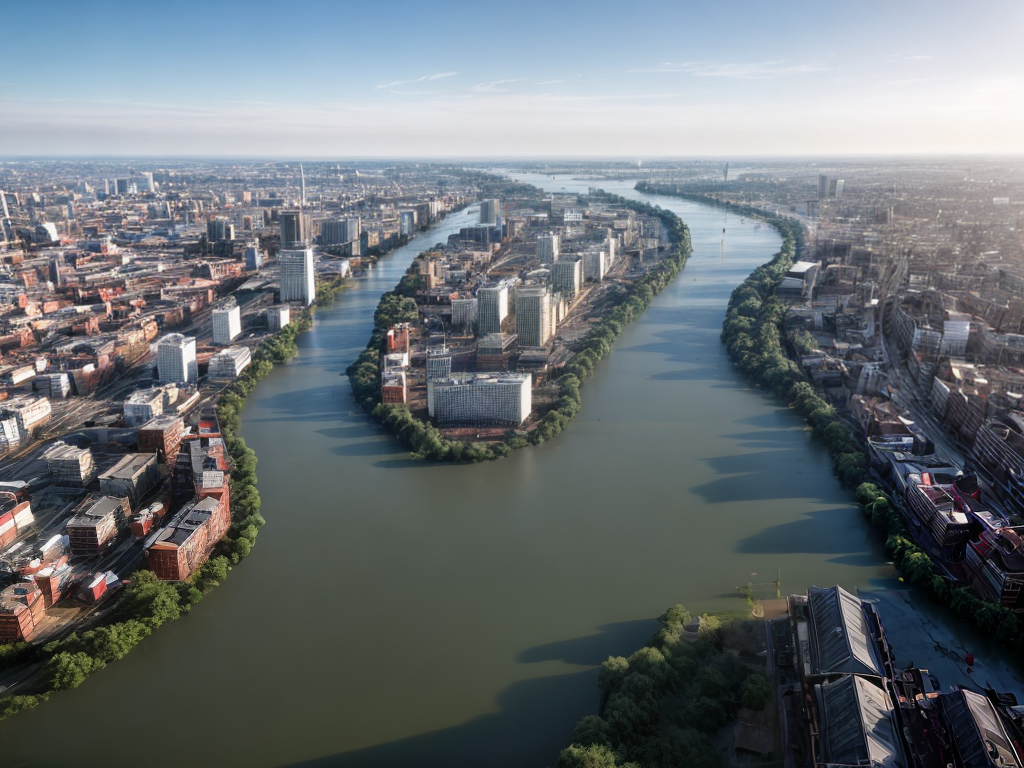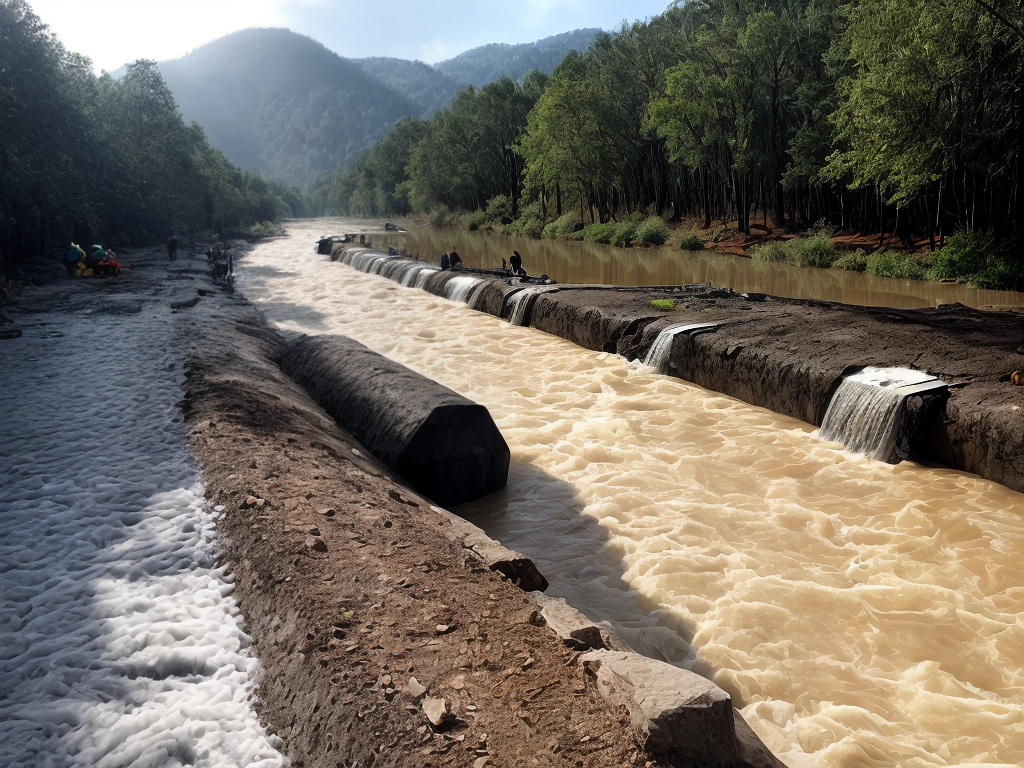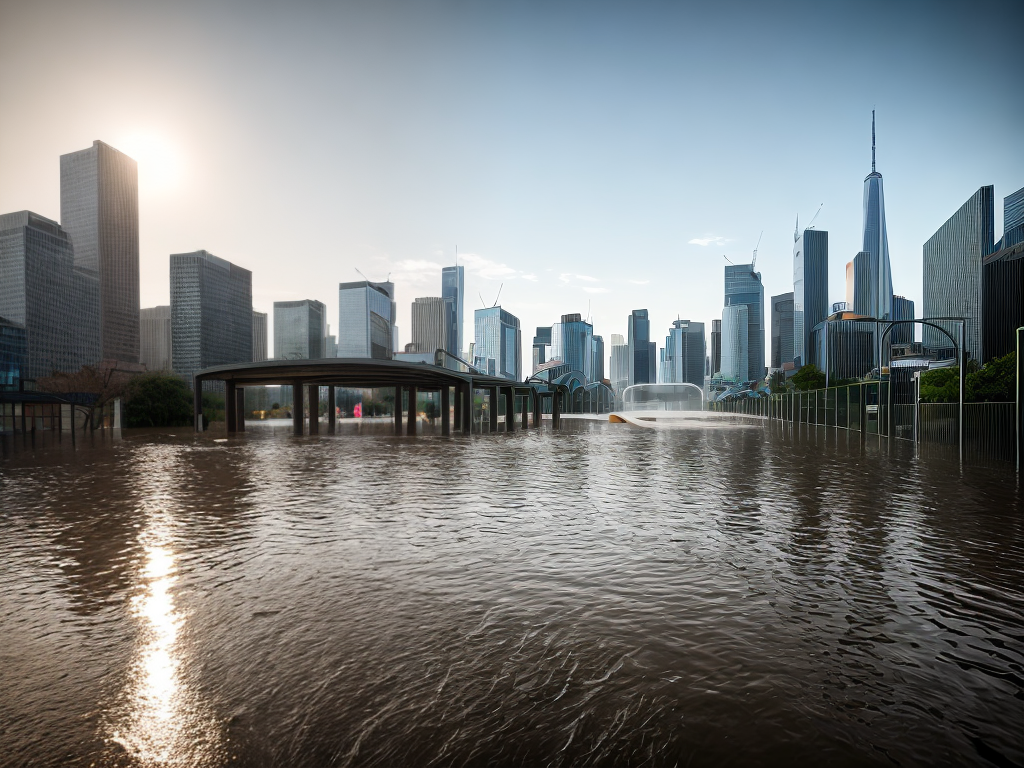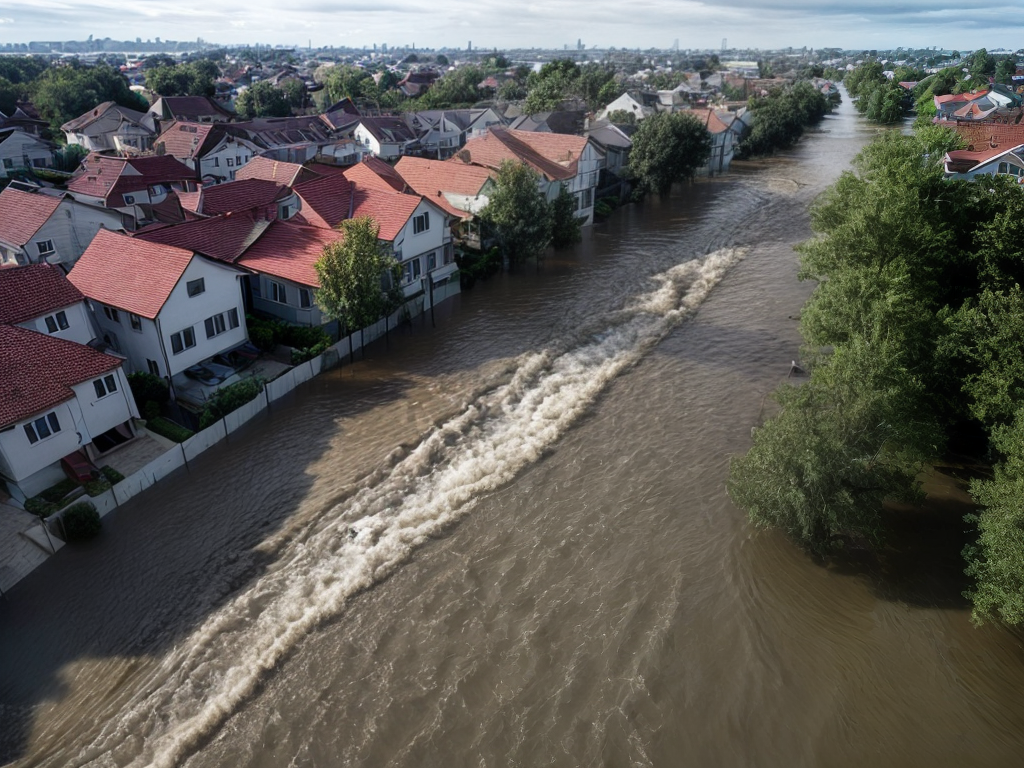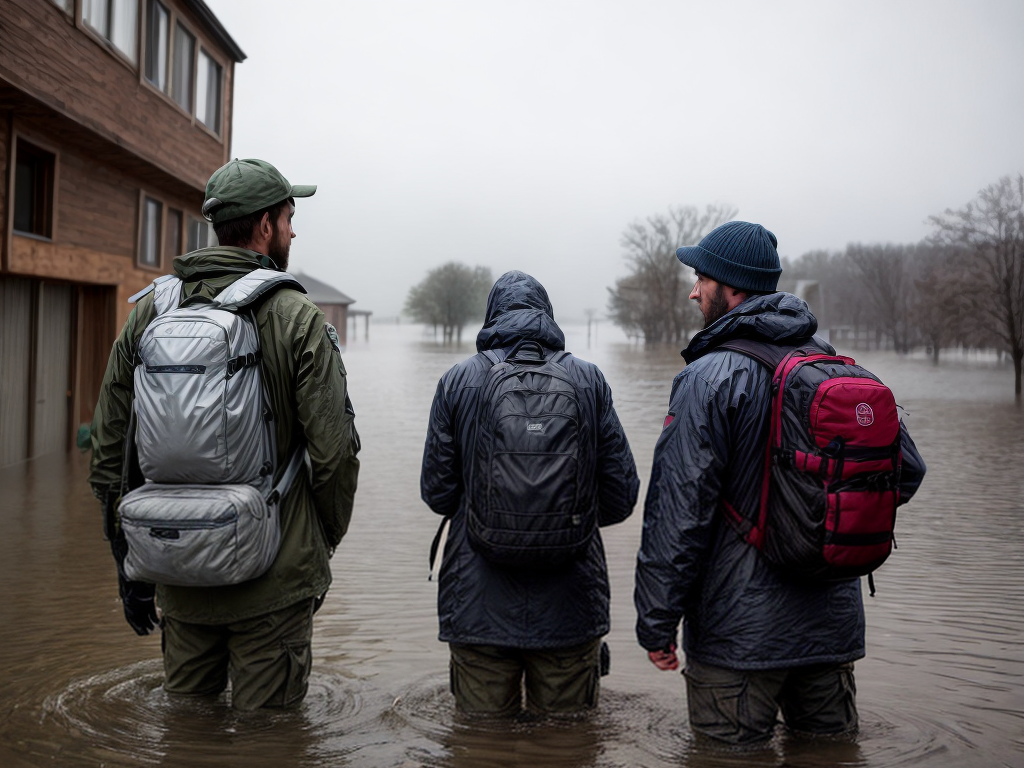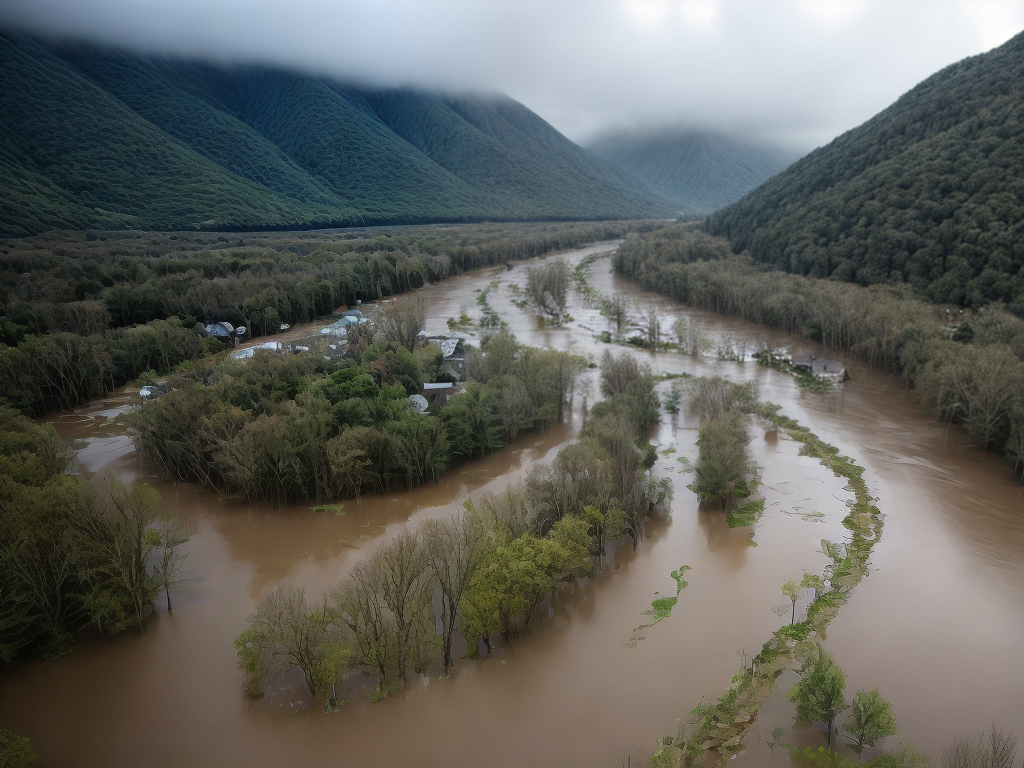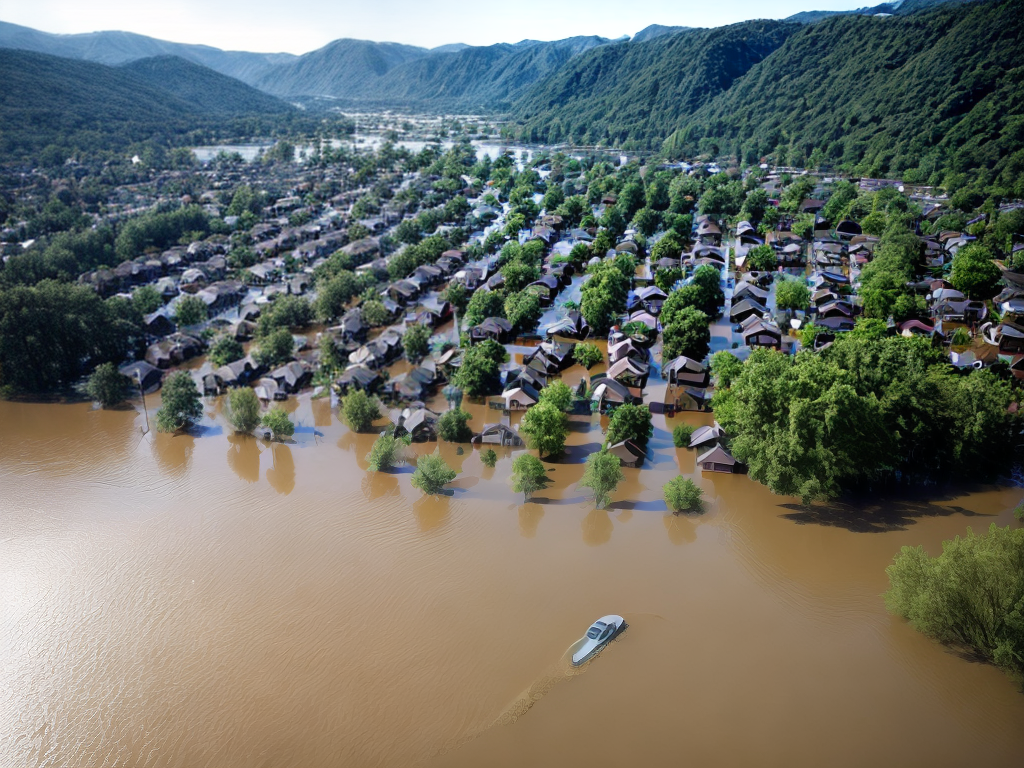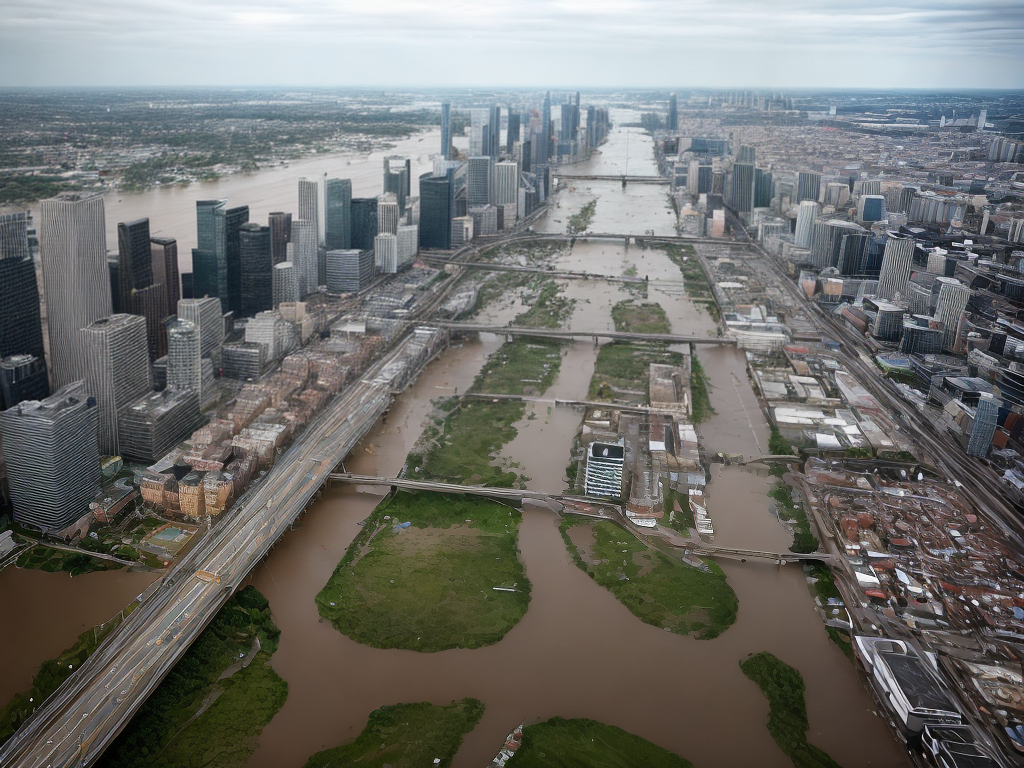
Like a sturdy wall against a relentless tide, innovative flood barriers in urban settings have emerged as a crucial defense against the devastating impact of flooding. These cutting-edge solutions not only protect our cities from the ever-increasing threat of rising water levels but also pave the way for a more resilient future. In this case study, we will explore fascinating examples of how flood barriers have been implemented in diverse urban environments, showcasing their effectiveness and potential for transformative change. From the bustling streets of New York City to the dynamic landscapes of Shanghai and the vulnerable coastlines of Miami, these case studies will unveil the ingenious approaches taken to prevent urban flooding. Get ready to discover the economic benefits, sustainable design solutions, and future trends that make these flood barriers a beacon of hope in the face of nature’s fury.
Key Takeaways
- Integration of smart sensor technology allows for real-time data collection and analysis, enhancing the effectiveness of flood barrier systems.
- Modular design flexibility enables customizable barrier configurations, adapting to the specific needs and requirements of urban environments.
- Remote monitoring capabilities enable continuous surveillance and maintenance of flood barrier systems, ensuring optimal performance.
- Early detection of rising water levels through advanced technology enables proactive measures to be taken, minimizing damage and protecting lives and property.
Importance of Flood Protection in Urban Areas
In urban areas, flood protection is of utmost importance for safeguarding the lives and property of residents. As cities continue to expand and urban infrastructure becomes more vulnerable to extreme weather events, it is crucial to prioritize flood preparedness. The increasing frequency and intensity of floods necessitate innovative solutions that can effectively mitigate the risks associated with urban flooding.
To address this challenge, city planners and engineers are embracing innovative flood protection measures that integrate seamlessly into urban environments. These measures include the installation of flood barriers, such as deployable flood walls and flood gates, which can be activated during flood events to protect vulnerable areas. These barriers are designed to withstand the force of floodwaters, preventing them from inundating urban infrastructure and causing extensive damage.
In addition to physical barriers, advancements in technology have also played a significant role in enhancing flood preparedness in urban areas. Real-time monitoring systems, satellite imagery, and predictive modeling enable early detection and accurate forecasting of floods. This allows authorities to implement proactive measures, such as evacuation plans and emergency response strategies, to minimize the impact of flooding on urban communities.
Moreover, community engagement and awareness are vital components of effective flood protection in urban areas. By educating residents about flood risks, promoting individual preparedness, and fostering a sense of shared responsibility, cities can create a resilient and proactive community that actively participates in flood mitigation efforts.
Technological Advancements in Flood Barrier Systems
When it comes to technological advancements in flood barrier systems, there are several key points to consider. First, smart sensor integration allows for real-time data collection and analysis, enabling faster and more accurate responses to changing flood conditions. Second, modular design flexibility allows for customizable barrier configurations that can adapt to different urban settings and flood risk levels. Lastly, remote monitoring capabilities enable continuous surveillance and maintenance of flood barriers, ensuring their effectiveness and reliability.
Smart Sensor Integration
Our integration of smart sensors into flood barrier systems has revolutionized urban protection against flooding. By incorporating these advanced sensors, we are able to gather real-time data on water levels, pressure, and other crucial factors. This data is then analyzed using cutting-edge techniques to provide accurate and timely information on potential flood risks. The use of smart sensors allows for early detection of rising water levels, enabling authorities to take proactive measures and mitigate the impact of floods on urban areas. The integration of these sensors also enables us to remotely monitor and control the flood barrier systems, optimizing their efficiency and effectiveness. Through continuous improvement and innovation, we are committed to creating flood barrier systems that are smarter, more responsive, and better equipped to safeguard our cities.
Modular Design Flexibility
By embracing modular design flexibility, we have enhanced the technological advancements in flood barrier systems, offering even more effective protection against urban flooding. Our modular construction approach allows for adaptability and customization, ensuring that our flood barriers seamlessly integrate into any urban environment. Here are three reasons why our modular design is a game-changer:
- Versatility: Our flood barriers can be easily reconfigured and expanded to fit the unique needs of any urban setting. This adaptability ensures maximum coverage and protection, regardless of the changing flood risk.
- Efficiency: With our modular design, installation and maintenance become a breeze. The standardized components can be quickly assembled and disassembled, saving time and resources.
- Future-proofing: Our adaptive design allows for easy upgrades and integration of new technologies. As flood protection needs evolve, our flood barriers can be easily modified to meet the latest standards.
With our modular design flexibility, we are revolutionizing flood barrier systems, providing innovative solutions for urban resilience.
Remote Monitoring Capabilities
With the integration of remote monitoring capabilities, flood barrier systems have become more efficient and responsive in detecting and addressing potential urban flooding risks. These advancements in technology have enabled the development of remote monitoring applications that provide real-time data analysis capabilities, allowing for proactive decision-making and timely response to flood events. By remotely monitoring the flood barrier systems, operators can quickly identify any potential issues or malfunctions, ensuring that they can be addressed promptly before they escalate into larger problems. The data analysis capabilities of these remote monitoring applications also enable the identification of patterns and trends in flood events, helping urban planners and policymakers make informed decisions regarding flood mitigation strategies. Overall, the integration of remote monitoring capabilities in flood barrier systems has revolutionized the way we manage urban flooding and has significantly improved our ability to protect communities from the devastating impacts of floods.
Sustainable Design Solutions for Urban Flood Barriers
Sustainable design solutions for urban flood barriers focus on implementing environmentally friendly and resilient infrastructure to mitigate the impact of flooding in cities. These solutions not only address the immediate challenges of flood management but also promote long-term sustainability and community engagement. Here are three key strategies that evoke an emotional response and highlight the innovative nature of these solutions:
- Green infrastructure integration: By incorporating elements such as green roofs, rain gardens, and permeable pavements into flood barrier designs, we can create a harmonious blend of nature and urban infrastructure. This not only helps to manage stormwater runoff effectively but also enhances the aesthetic appeal of the surrounding environment, fostering a sense of pride and connection within the community.
- Community participation and education: Engaging the local community in the design and implementation of flood barrier projects instills a sense of ownership and empowerment. By organizing workshops, public consultations, and educational campaigns, we can foster a deeper understanding of sustainable flood management and encourage individuals to take proactive measures to protect their neighborhoods. This collaborative approach builds social resilience while nurturing a culture of innovation and shared responsibility.
- Adaptive design for future uncertainties: Climate change brings unprecedented challenges, making it essential to design flood barriers that can adapt to evolving circumstances. Incorporating flexible design features such as adjustable floodgates, modular components, and adaptable drainage systems ensures that our infrastructure remains effective and resilient in the face of changing flood patterns. This forward-thinking approach reassures communities that we are prepared for the uncertainties of the future, instilling a sense of hope and confidence.
Case Study: Flood Barriers in New York City
In our case study of flood barriers in New York City, we witnessed the impressive resilience of the city’s infrastructure in the face of frequent and severe flooding. This case study serves as a valuable lesson for other coastal cities grappling with the challenges of implementing flood barriers in urban settings.
New York City, being a coastal metropolis, is particularly vulnerable to the impact of rising sea levels and extreme weather events. The city has taken proactive measures to protect its population and infrastructure from the devastating effects of flooding. The implementation of flood barriers has been a crucial aspect of this strategy.
One of the key challenges faced in implementing flood barriers in New York City was the need to balance functionality with aesthetic considerations. As an innovative and forward-thinking city, New York wanted flood barriers that not only effectively protected against floods but also seamlessly integrated into the urban landscape. This required careful design and engineering to ensure that the barriers were both effective and visually appealing.
Another challenge was the complexity of the city’s infrastructure. New York City is home to a vast network of underground utilities, transportation systems, and buildings. Installing flood barriers without disrupting these vital systems required meticulous planning and coordination.
Despite these challenges, New York City has successfully implemented flood barriers that have proven effective in protecting against flooding. The city’s innovative approach has served as a model for other coastal cities facing similar issues. By studying their case, these cities can learn valuable lessons and adapt the strategies to suit their unique circumstances.
Innovative Approaches to Urban Flood Prevention
When it comes to preventing floods in urban areas, there are several innovative approaches to consider. First, conducting a thorough urban flood risk assessment is crucial in identifying vulnerable areas and implementing targeted flood prevention measures. Additionally, sustainable flood management practices, such as green infrastructure and stormwater management systems, can help mitigate the impact of floods on urban communities. Lastly, community engagement strategies play a vital role in raising awareness, fostering resilience, and ensuring effective implementation of flood prevention measures.
Urban Flood Risk Assessment
Our approach to assessing urban flood risk involves implementing innovative strategies for prevention and mitigation. By employing cutting-edge technologies and advanced urban flood modeling techniques, we can accurately identify areas prone to flooding and develop effective solutions. Our urban flood risk management methodology is designed to not only protect urban areas from the devastating effects of flooding but also to minimize the disruption caused by such events.
- Our innovative strategies help communities to be better prepared for flood events, reducing the impact on residents and infrastructure.
- We utilize real-time data and predictive analytics to forecast flood risks, enabling proactive response and decision-making.
- Our approach focuses on community engagement and participation, empowering residents to actively contribute to flood prevention efforts.
Through our innovative urban flood risk assessment methods, we are revolutionizing the way cities manage and respond to flood events, ultimately creating safer and more resilient urban environments.
Sustainable Flood Management
One effective approach to urban flood prevention involves implementing innovative and sustainable strategies. As cities continue to face the challenges of climate change adaptation, it is crucial to develop flood management systems that not only protect urban areas from flooding but also promote sustainable infrastructure. Sustainable infrastructure refers to the use of environmentally friendly materials and practices that minimize the impact on natural resources. By incorporating sustainable infrastructure into flood prevention measures, cities can reduce their carbon footprint while also enhancing their resilience to future flood events. Additionally, climate change adaptation plays a significant role in sustainable flood management. This involves anticipating and preparing for the potential impacts of climate change, such as increased rainfall intensity, rising sea levels, and more frequent extreme weather events. By adopting innovative approaches to urban flood prevention, cities can create a sustainable future while effectively managing flood risks.
Community Engagement Strategies
As we explore innovative approaches to urban flood prevention, it is essential to highlight the significance of community engagement strategies. Public participation and community involvement are crucial elements in creating effective flood prevention measures that resonate with the needs and aspirations of the people. To evoke an emotional response in the audience, consider the following:
- Empowerment: Engaging the community in decision-making processes gives them a sense of ownership and empowerment over flood prevention initiatives.
- Collaboration: Encouraging collaboration between community members, local authorities, and experts fosters a collective effort to find innovative solutions to urban flooding.
- Education: Providing the community with the necessary knowledge about flood risks and prevention strategies empowers them to make informed decisions and take proactive measures.
Case Study: Flood Barriers in Tokyo
Tokyo’s flood barriers have proven to be an effective defense system against the city’s frequent and devastating floods. As a case study, the flood barriers in Tokyo showcase innovative solutions that effectively protect the city from the destructive forces of nature. Let’s delve into the details of Tokyo’s flood barriers and explore their remarkable features.
To better understand the effectiveness of Tokyo’s flood barriers, let’s take a closer look at their key features in the table below:
| Feature | Description |
|---|---|
| Modular Design | Tokyo’s flood barriers are built using a modular design, allowing for easy assembly and disassembly as needed. |
| Height Adjustable | These flood barriers can be adjusted to different heights, enabling them to adapt to varying flood levels. |
| Advanced Water Sensors | Equipped with advanced water sensors, the flood barriers automatically detect rising water levels and activate them. |
| Rapid Deployment | Tokyo’s flood barriers can be rapidly deployed in the event of an impending flood, ensuring prompt protection. |
| Reinforced Materials | Built with reinforced materials, these flood barriers offer increased durability and strength against floodwaters. |
| Integrated Communication | The flood barriers in Tokyo are integrated with a communication system, allowing for real-time updates and alerts. |
Tokyo’s flood barriers are a prime example of innovation in flood protection. The modular design and height adjustability provide flexibility and adaptability, making them suitable for various flood scenarios. The advanced water sensors and rapid deployment capabilities ensure swift action when needed, preventing extensive damage to the city. Additionally, the use of reinforced materials enhances their resilience, while the integrated communication system keeps residents informed and safe during flood events.
Tokyo’s flood barriers serve as an inspiration for other cities grappling with flood-related challenges. By adopting innovative solutions like these, urban areas can effectively mitigate the devastating impact of floods and safeguard their communities.
Community Engagement in Urban Flood Protection
As we explore the topic of community engagement in urban flood protection, it is important to consider three key points: public awareness campaigns, collaborative flood mitigation efforts, and interactive flood education. By raising public awareness about the risks and impacts of flooding, we can empower communities to take proactive measures to protect themselves. Collaborative efforts between government agencies, community organizations, and residents can lead to more effective flood mitigation strategies. Additionally, interactive flood education programs can equip individuals with the knowledge and skills needed to respond to and recover from flood events.
Public Awareness Campaigns
Our community’s engagement in urban flood protection is crucial for the success of public awareness campaigns. To evoke an emotional response in our audience, we can implement the following strategies:
- Public-Private Partnerships: By partnering with local businesses and organizations, we can create a sense of unity and collective responsibility in tackling urban flooding. This collaboration not only fosters innovation but also demonstrates a shared commitment to protecting our community.
- Social Media Campaigns: Leveraging the power of social media platforms, we can reach a wider audience and inspire action. Engaging and interactive content, such as videos and infographics, can educate and empower individuals to take proactive measures against flooding.
- Community Empowerment: Encouraging community members to share their flood protection stories and experiences can create a sense of solidarity and motivate others to get involved. By highlighting success stories and showcasing innovative solutions, we can inspire our community to become active participants in urban flood protection.
Collaborative Flood Mitigation
Collaborative flood mitigation is essential for effective urban flood protection, requiring active engagement from community members and stakeholders. To address the complex challenges of urban flooding, it is crucial to establish collaborative partnerships between different organizations, government agencies, and local communities. By working together, these stakeholders can develop and implement innovative flood risk reduction strategies. This collaborative approach allows for the pooling of resources, knowledge, and expertise, enabling the creation of comprehensive and sustainable flood protection measures. Through community engagement, residents can contribute their insights and experiences, helping to shape flood mitigation strategies that are tailored to the specific needs of their neighborhoods. By fostering collaboration and involving all relevant parties, cities can enhance their flood resilience and create a safer and more sustainable urban environment.
Interactive Flood Education
To enhance urban flood protection, community engagement in the form of interactive flood education is crucial. Interactive learning allows individuals to actively participate in the learning process, making it more engaging and memorable. Here are three reasons why interactive flood education is essential for our community:
- Empowerment: By actively participating in flood education, community members gain the knowledge and skills needed to protect themselves and their properties during flood events. This empowers individuals to take proactive measures and make informed decisions, reducing the impact of flooding on their lives.
- Collaboration: Interactive flood education fosters collaboration between community members, local authorities, and experts. Through workshops, simulations, and community forums, participants can exchange ideas, share experiences, and collectively develop innovative flood protection strategies.
- Resilience: By engaging in interactive flood education, the community becomes more resilient in the face of flooding. This education equips individuals with the tools and resources needed to adapt to changing flood patterns, recover quickly, and build a safer and more sustainable future.
Case Study: Flood Barriers in Amsterdam
The implementation of flood barriers in Amsterdam has significantly reduced the risk of flooding in the city. These innovative flood barriers have proven their effectiveness in enhancing urban flood preparedness. Amsterdam, known for its intricate canal system, has always been vulnerable to flooding. However, with the introduction of these flood barriers, the city has taken a giant leap towards ensuring the safety of its residents and infrastructure.
The flood barriers in Amsterdam are a testament to the city’s commitment to innovation and proactive urban planning. These barriers are designed to withstand rising water levels and provide a robust defense against flooding. By strategically placing these barriers along vulnerable areas, Amsterdam has created a comprehensive flood protection system.
One of the key features of these flood barriers is their ability to adapt to changing water levels. They are equipped with advanced sensors and automated mechanisms that monitor water levels in real-time. This allows for quick adjustments to ensure optimal flood protection. The barriers can be activated swiftly to prevent water from entering the city during high tides or heavy rainfall.
Apart from their functional aspects, these flood barriers also blend seamlessly into the urban landscape, showcasing Amsterdam’s commitment to aesthetics and urban design. Their sleek and modern design adds to the city’s charm while providing a sense of security to its residents.
Integrating Flood Barriers Into Urban Landscapes
As we explore the integration of flood barriers into urban landscapes, we can see how these innovative structures seamlessly blend into the cityscape while providing vital protection against flooding. Urban flood barrier integration has become a necessity in cities around the world, as the threat of rising sea levels and extreme weather events continues to grow. To meet the challenges of urban flood barrier design, engineers and architects are pushing the boundaries of innovation to create solutions that not only safeguard against flooding but also enhance the aesthetic appeal of urban environments.
- Enhanced aesthetics: Urban flood barriers are no longer eyesores that disrupt the visual harmony of a city. Instead, they are designed to complement and enhance the urban landscape, incorporating elements such as green spaces, public art installations, and recreational areas. This integration not only provides functional flood protection but also creates a sense of beauty and vibrancy in the city.
- Community engagement: The integration of flood barriers into urban landscapes encourages community engagement and participation. Citizens are involved in the design process, allowing them to have a say in shaping their environment. This sense of ownership fosters a stronger connection between the community and its surroundings, instilling a sense of pride and empowerment.
- Sustainable solutions: Urban flood barrier integration goes beyond mere functionality. It embraces sustainable practices, such as the use of renewable energy sources, green infrastructure, and water management systems. These innovative approaches not only mitigate the impact of flooding but also contribute to the overall sustainability of the urban landscape.
Case Study: Flood Barriers in London
Let’s take a closer look at the flood barriers in London, a case study in effective flood protection. London’s barrier system has been instrumental in safeguarding the city from rising water levels and preventing catastrophic flooding. By implementing these flood barriers, London has demonstrated its commitment to proactive measures and has set a precedent for other urban areas facing similar challenges.
London’s Barrier System
London’s barrier system effectively protects the city from devastating floods. This innovative flood prevention measure showcases London’s commitment to staying ahead of the curve in urban flood management. Here are three reasons why London’s barrier system is a game-changer:
- Unparalleled Design: The barrier system seamlessly integrates cutting-edge technology with elegant architecture, creating a visually stunning solution that complements the city’s landscape. It not only serves its purpose but also adds to the city’s charm.
- Proactive Approach: London’s barrier system is not just a reactive measure; it is a proactive solution that anticipates the rising threat of floods. By constantly adapting and evolving, it ensures that the city remains well-prepared for any future challenges.
- Collaborative Effort: The development and maintenance of London’s barrier system involve a collective effort from various stakeholders, including engineers, designers, and city officials. This collaborative approach fosters innovation and ensures that the system continues to be at the forefront of flood prevention technology.
London’s barrier system embodies the spirit of innovation and serves as a shining example of how cities can tackle the threat of floods in a forward-thinking manner.
Implementing Flood Protection
Now let’s shift our focus to the practical implementation of flood protection measures, specifically looking at the case study of flood barriers in London. Implementing flood protection in urban areas is crucial for preventing devastating floods and safeguarding communities. In London, an innovative flood barrier system has been put in place to combat rising water levels and protect the city from potential disasters. This system consists of state-of-the-art barriers strategically located along the River Thames. The table below provides an overview of the key features and benefits of these flood barriers:
| Features | Benefits |
|---|---|
| Advanced technology | Provides real-time data and early warning systems |
| Modular design | Allows for easy installation and adaptability to changing needs |
| Environmentally friendly materials | Minimizes the impact on the ecosystem |
| Integrated management system | Enables efficient coordination and response to flood events |
Overcoming Challenges in Implementing Urban Flood Barriers
Implementing urban flood barriers presents several challenges that need to be overcome. As we strive for innovation in flood protection, it is important to address these challenges head-on and find effective solutions. Here are some of the key challenges and potential solutions that can help us overcome them:
- Financial constraints: Developing and implementing flood barriers in urban areas can be a costly endeavor. However, by partnering with governments, and private organizations, and seeking funding from grants and insurance programs, we can secure the necessary financial resources to implement these barriers effectively.
- Infrastructure limitations: Urban environments often have limited space and existing infrastructure, making it challenging to find suitable locations for flood barriers. By leveraging advanced technologies such as modular and adaptable barrier systems, we can overcome these limitations and find innovative ways to integrate flood protection into urban landscapes.
- Community acceptance: Introducing flood barriers in urban areas may face resistance from local communities due to concerns about aesthetics and potential disruptions. To address this challenge, it is crucial to involve the community in the decision-making process and communicate the benefits of flood protection measures effectively. Additionally, incorporating architectural and design elements that blend with the urban environment can help enhance community acceptance.
Case Study: Flood Barriers in Shanghai
To understand the effectiveness of flood barriers in urban settings, let’s examine a case study focused on Shanghai. In recent years, Shanghai has been at the forefront of implementing smart flood prevention measures and innovative infrastructure to combat the increasing risk of floods in the city.
One of the key initiatives in Shanghai is the construction of an extensive network of flood barriers along the Huangpu River, which runs through the heart of the city. These flood barriers are equipped with advanced technologies and sensors that monitor water levels in real time. This allows authorities to promptly respond to potential flood threats and take necessary actions to mitigate the risk.
Furthermore, Shanghai has implemented an integrated flood management system that combines flood barriers with intelligent forecasting and early warning systems. By analyzing data from weather stations, river gauges, and rainfall monitoring devices, the system can accurately predict the likelihood and severity of floods. This enables the city to proactively prepare and implement appropriate measures to protect its residents and infrastructure.
In addition to physical flood barriers, Shanghai has also embraced innovative infrastructure solutions. For instance, the city has integrated permeable pavements and green spaces into its urban planning. These features can absorb and drain rainwater, reducing the strain on the drainage system during heavy rainfall events.
The success of Shanghai’s smart flood prevention and innovative infrastructure measures has significantly improved the city’s resilience to floods. By leveraging advanced technologies and adopting a holistic approach, Shanghai has demonstrated its commitment to creating a safer and more sustainable urban environment. This case study serves as an inspiration for other cities facing similar challenges, highlighting the importance of innovation in flood prevention strategies.
Economic Benefits of Investing in Urban Flood Protection
Shanghai’s commitment to smart flood prevention measures and innovative infrastructure not only enhances its resilience to floods but also brings significant economic benefits through investing in urban flood protection.
- Cost-effective solutions: By investing in flood protection measures, Shanghai can minimize the economic losses caused by floods. The implementation of cost-effective solutions such as flood barriers and levees prevents the destruction of infrastructure, reduces property damage, and minimizes the need for costly emergency response and recovery efforts. This proactive approach saves the city a considerable amount of money in the long run.
- Long-term benefits: Investing in urban flood protection brings long-term economic benefits to Shanghai. By safeguarding critical infrastructure and reducing the frequency and severity of flood damage, the city can maintain its functionality and productivity even during extreme weather events. This stability attracts businesses, investors, and talent, boosting economic growth and creating new job opportunities. Additionally, the protection of residential areas ensures that people can continue living and working in the city without the fear of displacement, preserving social cohesion and community well-being.
- Innovation and progress: Shanghai’s investment in urban flood protection demonstrates its commitment to innovation and progress. By seeking out and implementing cutting-edge technologies and solutions, the city sets itself apart as a leader in flood prevention. This not only enhances its reputation but also attracts experts and innovators who want to be part of the city’s forward-thinking approach. The economic benefits derived from this investment further fuel the cycle of innovation, creating a virtuous cycle of growth and development.
Case Study: Flood Barriers in Miami
Miami has implemented flood barriers to protect against the increasing threat of flooding in the city. The efficacy of flood barriers in coastal cities like Miami cannot be overstated. As an innovative solution, flood barriers have proven to be highly effective in protecting vulnerable areas from the devastating impacts of flooding.
The role of the government in implementing flood protection measures is crucial. In Miami, the government has taken proactive steps to invest in flood barriers as part of its comprehensive flood management strategy. Recognizing the urgency and severity of the issue, they have prioritized the implementation of flood barriers to safeguard their coastal communities.
The efficacy of flood barriers in Miami is evident in their ability to mitigate the risks associated with rising sea levels and extreme weather events. By providing a physical barrier against floodwaters, these innovative structures help prevent damage to properties and infrastructure. They also reduce the disruption caused by evacuation and recovery efforts, ensuring the resilience of the city’s urban fabric.
The government’s commitment to implementing flood protection measures demonstrates its dedication to the well-being of its citizens and the sustainability of the city. By investing in flood barriers, Miami is setting an example for other coastal cities facing similar challenges. Through collaboration with experts and stakeholders, they have been able to develop and implement innovative flood protection solutions.
Future Trends in Urban Flood Barrier Technology
As we look ahead to the future, advancements in urban flood barrier technology hold great promise for protecting vulnerable cities from the increasing threats of flooding. The ever-growing need for innovative flood protection solutions has led to the development of cutting-edge technologies that can revolutionize the way we safeguard our urban infrastructure. Here are some exciting future trends in urban flood barrier technology that are set to shape the landscape of flood protection:
- Smart Sensors and Monitoring Systems: Future innovations in flood barrier technology will incorporate smart sensors and monitoring systems that can provide real-time data on water levels, structural integrity, and potential breaches. These advanced systems will enable early detection and timely response to flood events, ensuring swift and effective protection for urban areas.
- Modular and Flexible Designs: To adapt to the dynamic nature of urban environments, flood barriers of the future will feature modular and flexible designs. These barriers will be customizable and easily deployable in various settings, offering adaptable flood protection solutions that can be tailored to the unique needs of different cities.
- Green and Sustainable Solutions: With a growing focus on sustainability, future flood barriers will integrate eco-friendly materials and renewable energy sources. These green solutions will not only provide flood protection but also contribute to the overall sustainability of urban infrastructure, aligning with the desires of an audience that seeks innovation and environmental consciousness.
The future of urban flood barrier technology holds immense potential to revolutionize flood protection strategies. By incorporating smart sensors and monitoring systems, modular and flexible designs, and green and sustainable solutions, we can create a resilient urban infrastructure that can withstand the challenges posed by flooding. These advancements will not only enhance the safety and well-being of urban populations but also contribute to the sustainable development of our cities.
